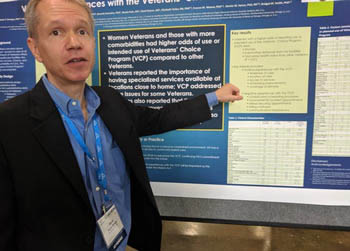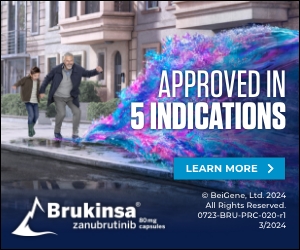
Kevin Stroupe, PhD, best poster awardee at Academy Health’s ARM 19. He presented the study, stating, “Veterans Choice led to some positive as well as negative experiences for vets. Future investigation of the impact of the Mission Act will be important to assess these issues further.” Photo from VA HSR&D Twitter feed
HINES, IL—Women and veterans with multiple comorbidities used and valued the Veterans Choice Program (VCP) more than other veterans, according to recent research by the VA.1
To help these veterans and others, the VA has taken steps under the MISSION Act to improve access and communication with community providers so that they better understand the unique concerns of veterans and how to work with the VA to provide continuity of care.
The Veterans Choice Program made healthcare services available to veterans through non-VA providers if the veteran would have a wait time of more 30 days or lives more than 40 miles from or faces travel challenges to get to a VA healthcare facility.
The researchers conducted both qualitative and quantitative analyses to determine which veterans used or intended to use VCP and what their experiences were with the program. The team sent surveys to 18,854 veterans in the Midwest, of which 4,525 responded and 2,989 expressed interest in using or past use of the VCP. The team then conducted telephone interviews with a subset of 60 respondents between January and July 2017.
To a large degree, they found that the use of VCP closely paralleled the reasoning for implementing the program—the ability to access specialty services not available at local VA facilities, demand for more frequent appointments, and need for care closer to home.
Veterans who used or planned to use the VCP and those who did not were of similar age, racial distribution, and distance from a VA medical facility. Women veterans, however, were almost twice as likely to use or intend to use the program, 14.3% vs 7.8%.
That was in keeping with one of the major findings of the study. “Survey participants’ leading reason for VCP use was the need for specialty care services unavailable at their closest VA facility,” said lead author Kevin Stroupe, PhD, acting director of the VA Center of Innovation for Complex Chronic Healthcare based at the Hines, Ill., VAMC. Twenty-eight percent of respondents who used or intended to use VCP needed specialty care services not available at their closest VA facility.
The VA has substantially expanded services for women veterans in recent years, but “many gender-specific health services, such as mammography, and breast and cervical oncological services, may only be available in larger VA healthcare facilities with higher volumes of women veterans,” Stroupe told U.S. Medicine.
“VA has always allowed access to non-VA care from community providers when gender-specific care is not available at a VA healthcare facility. The same continues through VCP,” Stroupe said. As a result, a larger proportion of women veterans continue to receive non-VA healthcare compared to their male counterparts.
Distance from a VA medical facility also increased the use of VCP, with 21% of VCP users saying that they wanted access to care closer to home. The researchers identified some interesting anomalies in the data around distance. The odds of using community care was 47% higher for veterans who lived five to 40 miles from a VA facility. Veterans who lived more than 40 miles away had no significantly increased odds of VCP use, however.
“Veterans living more than 40 miles or in rural areas have fewer choices when accessing non-VA facilities through VCP referrals,” Stroupe noted. Many rural areas in the U.S. have very limited medical facilities and specialists are hard to find. While urban areas in the U.S. have 263 specialists per 100,000 people, rural areas have just 30 per 100,000, according to The National Rural Health Association.
In addition to distance and need for specialty services, health status drives much of the use of VCP, the researchers found. This “may be attributable to the added burden of travel or cumulative wait times experienced by veterans needing more frequent visits,” the authors said.
Veterans with multiple comorbidities are also more likely to have one or more issue that needs immediate attention and may find that “the wait time was too long at their VA facility. This finding highlights the importance of ensuring that veterans with complex, chronic conditions are aware of and capable of leveraging the VCP for their needs,” they added.
Many of the veterans expressed appreciation for the increased access to services and the reduced wait time for appointments through VCP, but they continued to voice concerns about communication, the complexity of the referral process, and billing challenges.
MISSION Act
The MISSION Act, passed in 2018, aimed to improve access and care provided in the community to veterans. As part of the act, the Veterans Choice Program officially ended on June 6, 2019 and the VA rolled out a new community care program that combined the VCP and the VA’s traditional community care program. The nationwide implementation is expected to be completed by 2020.
“As we look to the future, we want to make sure we put choice in the hands of the Veteran and provide them access to care where and when they need it. We always consider the needs of our patients and want to ensure we have the right mix of providers available both in the VA and in the community with locations that are convenient to all veterans,” said VA Under Secretary for Health for Community Care Kameron Matthews, MD.
The new community care program expands eligibility to include veterans who need a service not available at the VA, live in a state or territory without a full-service VA medical center, has a more than 30 minute average drive time or 20 day wait for primary care, mental health, and non-institutional care or more than 60 minutes average drive time or 28 day wait for specialty care.
Some veterans are also “grandfathered” into the program and others may use it if they and their VA provider agree that the veteran’s best medical interest will be served by a referral to a community provider.
Eligible veterans may use the program’s new urgent care benefit to receive care through the VA’s network of community providers without prior authorization.
The VA is working to “equip community providers with information needed to successfully provide veteran care,” Matthews told U.S. Medicine. That effort includes online, no-cost continuing medical education and regular live webinars.
“So far in FY 2019, more than 2800 community providers have attended the live webinars,” Matthews said. “Even more providers have attended the on-line sessions that were recorded and hosted on VA’s learning platform, TMS, and on VHA TRAIN. VA had to obtain a larger, seminar Adobe Connect classroom (platform used to host webinars) to manage the growing number of attendees.”
- Stroupe KT, Martinez R, Hogan TP, Gordon EJ, Gonzalez B, Kale I, Osteen C, Tarlov E, Weaver FM, Hynes DM, Smith BM. Experiences with the Veterans’ Choice Program. J Gen Intern Med. 2019 Aug 6. doi: 10.1007/s11606-019-05224-y. [Epub ahead of print]

